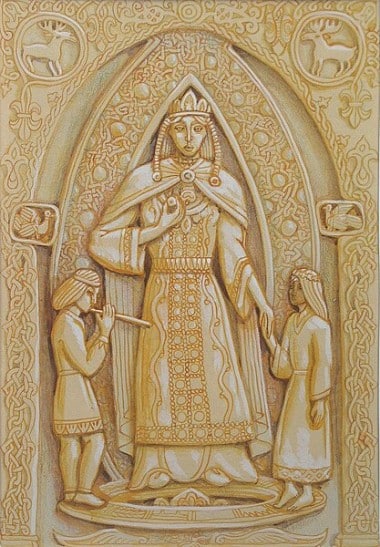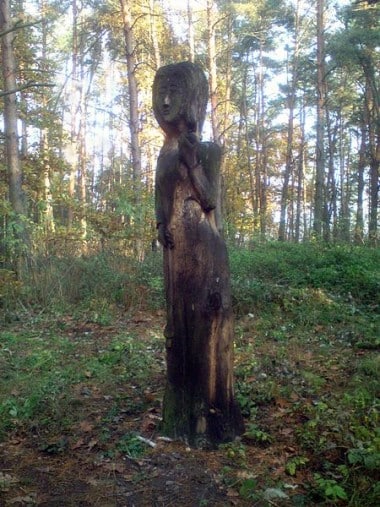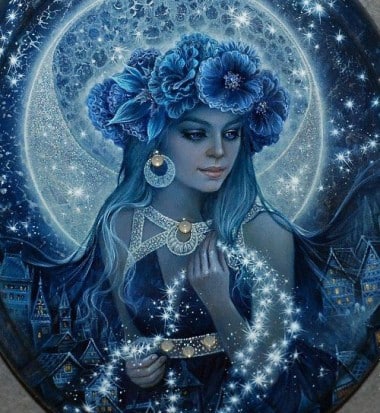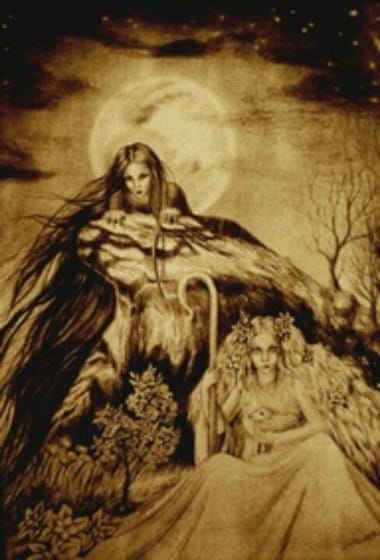For most of us, the word myths first conjures up images of Olympus, Zeus, Hercules, Aphrodite, and Venus. But as we know, all ancient mythology is pagan. And the mythology of the ancient Slavs, which is, unfortunately, little known to us and virtually unknown to the world, is actually no less interesting than Greek mythology. The pre-Christian beliefs of Ukrainians, which were based on the relationship between man and nature, are extremely rich. The amazingly interesting characters of our mythology, which scientists get knowledge about from the depths of folklore and the oldest surviving documents, reflect the spiritual world of our ancestors. So what gods did ancient Ukrainians believe in?
In Ukrainian mythology, there are many female characters who are associated with ideas about certain forces of nature, phenomena and images.
People believed in goddesses who preserved the harmony of the world, brought beauty, warmth and light. Each of them was responsible for certain processes and embodied the image of one of the most important aspects of life.
Lada

The goddess of harmony, beauty and love. The most beautiful of the goddesses. Lada brought living water to the world, coming to people across the Rainbow with a baby, an ear of wheat and flowers. In her hand she held a red apple with grapes. The baby is the incarnate world, and the apple, like the egg, is the beginning of all things. The sunlight then flashed with seven rainbow colours.
The myth of Lada tells us: “It was a long time ago, when the world was just beginning. There was neither sky nor earth, only a blue sea stretched out around them, and on it grew a green sycamore tree – the Tree of Life. This Tree of Life gave the world Lada, the goddess of world harmony.
The great holiday of Lada always comes when the snow begins to melt, lasts during the spring work and ends on Midsummer Day. Lada was especially honoured on 22 April. Girls, coming out to a clean meadow in spring, hold hands in a wreath circle and lead the freckled hayvky around the best among them.
The goddess Lada was also asked for good luck and fortune. So the next time you play slots at https://www.wantedwin7.com/en-AU, you can try asking Lada for her favour.
Mokosha
The goddess of mercy, female diligence and skill, as well as the goddess of fertility and life-giving female power. She is the patroness of pregnant women and women in labour. The goddess Mokosha is especially concerned with moisture (rain, streams, rivers), and therefore the great mother of all living things was also worshipped near wells, where there should always be an image of the goddess, as well as dishes so that a traveller could drink water.

The goddess Mokosha lives in the sky, as a princess-hostess, walking respectfully around the court of her lord. She always wears a golden robe, and on her belt, on a golden sling, she has golden keys that unlock the rains and fogs.
For a long time, Christians could not forget their ancient Goddess, so they honoured her in the image of St Paraskeva (Friday). Women’s temples of Mokosh, which were built, as a rule, at crossroads, were called “Pyatnitsy”.
The image of the mother goddess Mokoshi can be seen in ceramic sculptures found by archaeologists. The statuettes of Scythian goddesses (VII century BC) resemble the image of Mokoshi-Oranta with her hands raised in the air, as if in prayer, which we see in the Cathedral of St Sophia of Kyiv.
Dana
Dana is the goddess of water and rivers. She gives life to all living things. Some researchers believe that the names of the rivers come from Dana’s name: Dnipro, Dniester, Danube, Donets, Dvina. The word Dana means Da – water, Na – nenya, mother, that is, it means Mother Water.
Since ancient times, Dana, the fair goddess of all earthly waters and elements, has been washing the eternal Tree of Life with her wide and deep waters. The eternally beautiful, eternally fresh Maiden is also the wife of Dazhbog, his greatest solar power. It is their wedding that the gods and the whole world celebrate on Kupala. It is at this time that the goddess Dana and the god of fertility Simargl, through the power of the union of water and fire, generously bestow love on the world, and send a child to a mother to grow up healthy and happy to the joy of her parents. Our grandparents have always prayed to the pure spring waters of Mother Earth.
The goddess Dana is also the ruler of green-eyed mermaids, water maidens who know the secret of love; water workers, reed workers, marsh workers; those who break dams.
Lelya

Lelya is the daughter of Lada, the goddess of love, spring and beauty. The blue-eyed Lelya was born from the love of the earth and the sky. She was born from the bosom of pink rose petals of her magical mother, the goddess of the Universe, the wise Lada.
The goddess Lelya is a beautiful spring girl. She is blushing, with her braids loose like a bride’s, wearing a wreath of periwinkles and first spring flowers, and instead of ribbons, spring is flowing from her.
The myth about Lelya tells: Lelya appeared at the time when Lelya’s newly born twin brother, the god of the bright day Polel, flew away into the disturbed darkness as a white swan. From that unprecedented love, we humans were born, and the fragile rose flower became a symbol of the great love of the goddess Lela, an amulet of her secrets. Spring then exploded with blossoms and love, and the surface of lakes and rivers, which had been cold until then, spilled over, hugging each other in the heady smell of grass.
Our ancestors celebrated the holiday of the resurrection of the spring-sun of the divine Lela on her great day – 23 April. People called this maiden holiday “Lelnyk” and songs “ladovytsia” to keep the magic Lelya in order in their souls. Back then, they used to perform the “Crooked Dance” – a round dance where girls walk alone, holding each other’s hands. This tradition was preserved until recently in some regions of Ukraine.
Slava

The great goddess of war and victory. Her name is mentioned many times in the Book of Veles. Men went into battle with the image of the winged goddess on their shields. According to some scholars, the name of the Slavs comes from the name of Slava.
The goddess Slava came into the world when the huge Tree of Life was growing. Since those prehistoric times, in the struggle for living fire against the unawakened darkness of darkness, the wise goddess of the Universe Lada with great Slava immortalised those heroes, put them on a par with the gods and granted them the realm of human destiny.
When the enemy came to the native land, the goddess Slava called her glorious sons to battle and, giving them a sword in their hands, inspired them to do deeds. The goddess Slava is honoured on 1 September, when the holiday of the hearth is celebrated.
Slava is the guiding star of the people’s destiny, ordained by God. The goddess Slava breaks the shackles of bodily and spiritual bondage, and relieves the oppressed sense of dignity. Man then ceases to be a slave and becomes free and truly true to the faith of his ancestors and to the Lord God in heaven and on earth.
Marena
Marena is a maiden. In front of her is a ruddy, beautiful woman, behind her is a rotting, stinking corpse (Mara). Marena cuts the scar of life in the human heart with a rusty scythe. Mara (the dark essence of the goddess) has rotting, inflamed eyes instead of eyes, and therefore has no power and authority in heaven and on earth that could bring the human body back from the cold eternal sleep. Mara has thirteen daughters, the “marenyas”, who were born of the Serpent. They bring dark winter forces, incredible mental suffering, break bones, and throw people into the fire. Only the goddess Marena is able to drive away the evil Mara in the spring.
She is the ruler of the heavenly water kingdom. The water queen is also called Moryana, the sea goddess. Like the sea, she is forever mysterious with her immensity, and sometimes scary, like death. Sea water gives life both light and darkness. And Marena, without the tender sunny embrace of the sky of Dazhboh and the hot love of Kupala, is lifeless and cold, like ice in winter, like death. Cold, dark water, when not warmed by the light of the sun, brings only death. That is why Marena is both an angry water queen and a beautiful one.
Marena was commemorated on the night of 23-24 June, during the sacred wedding of the Fire King and the Water Queen. On this magical night, the most beautiful companion of Kupala is at her most fertile towards Mother Earth and the life-giving sun. At this time, the earth is already lushly covered with green leaves; the rye breads have braided their ears in the sky, and various great miracles have begun to take place in the environment. On this night, the Queen Water washes people’s bodies and souls.
Featured Image Credit: Midjourney

